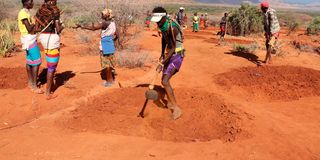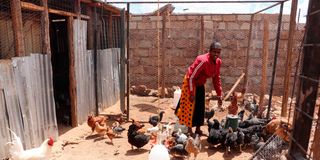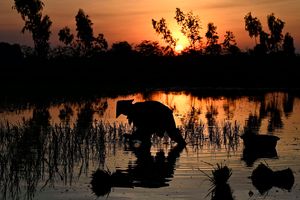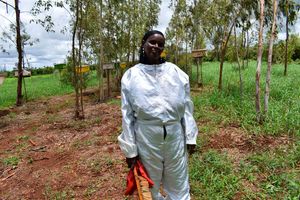Laikipia, Samburu and Isiolo join hands to fight climate change

Community members in Olturai Village within Leparwa Community Conservancy plant drought tolerant grasses using climate smart techniques
What you need to know:
- One of the targets of the LISTEN project is to ensure that communities have access to improved water and livelihood resource management at landscape level within the Ewaso Nyiro River Basin Ecosystem.
In the outskirts of Suguta Marmar shopping centre, about 40 kilometres out of the Samburu’s capital – Maralal, Santana Lemuna has become a household name. The 38-year-old mother of three is now one of the main suppliers of indigenous eggs in a community that has always undermined the value of chicken.
Lemuna is one of the residents of Logorate Village within Lolmolog Forest in Samburu County who fled their homes at the peak of Covid-19, to seek alternative sources of livelihoods following repeated attacks by bandits. And now with 66 indigenous birds on her plot in Suguta Marmar, Lemuna collects at least a tray of eggs every day, which earns her Sh4,200 per week from the local market.
“I am happy that I have these chicken because in this community, all the livestock belongs to men, but chicken are looked down upon to a point that my husband will never be bothered even if I sell some of them. He has never wanted to know how much I earn from the eggs,” she said.

Santana Lemuna attends to her chicken in Suguta Marmar. The chicken are an alternative source of livelihood for women in Samburu
Having been brought up in a pastoralist community, Lemuna never saw her parents keep chicken because when migrating from one place to another in search of water and greener pastures, it was not easy to carry chicken along.
“This is just one of the ideas we are trying to introduce to communities in arid and semi arid counties so that people can change their behaviour and accept alternative sources of livelihoods in the face of climate change and the challenges that come along,” said Stephen Gichuki, the manager of a project known as Laikipia, Isiolo and Samburu Transforming the Environment through Nexus (LISTEN).
Through the project, the three neighbouring counties are now working together in collaboration with the Netherlands development Organization, Alliance for a Green Revolution in Africa and the Frontier Counties Development Council (FCDC) to strengthen institutional capacities for climate change adaptation, increase smallholder farmers’ knowledge for building resilience, and for adoption of climate-smart irrigation technologies and practices.
“Lemuna, is among the Chemichemi women group members who have embraced change and are now able to generate alternative income through an enterprise that does not excite bandits, but above all, an income stream that women in such a pastoralist community can identify with,” said Gichuki.
According to Idle Omar Bare, the Chief Executive Officer at the FCDC, the nexus approach and bringing neighbouring counties together was so critical because counties are divided by invisible boundaries, and communities living within those boundaries share similar resources as well as environmental challenges.
“At the county level, we are also using the nexus approach to ensure that adaptation to climate change is integrated in all departments. This is because if they work in silos, you will get to a situation where two different departments are planning for the same thing, for example the agriculture sector is planning to sink a borehole in the same place where the water sector is planning for the same,” said Bare.
One of the targets of the LISTEN project is to ensure that communities have access to improved water and livelihood resource management at landscape level within the Ewaso Nyiro River Basin Ecosystem.
“In Isiolo for example, we are working with community members from Olturai Village within Leparwa Community Conservancy to regenerate their landscape by growing drought tolerant grasses using climate smart techniques, and replacing invasive tree species with environment friendly plants as a way of adapting to climate change,” said Florence Mwangangi, the director of Agriculture in Isiolo County.
“The alternative sources of income have come in very handy for most of the community members because in the recent past, we have seen pastoralists lose up to 100 per cent of livestock whenever drought strikes,” said Hassan Ali Jare, the secretary of Kinna Ward Planning Committee in Isiolo County.
The situation is the same in all the neighbouring counties. “Following the recent drought, it is estimated that almost 80 per cent of the livestock in Samburu County have died, with some households losing up to 100 per cent of what they had in terms of cattle and sheep,” said Benson Lengalen, the Samburu County Director in Charge of Environment, Climate Change, Natural Resources and Energy.
Whenever there is a need for irrigation, communities in the three counties are being encouraged to embrace solar water powered pumps, which are cost effective because they do not call for refuelling, and at the same time they do not pollute the environment.
In Laikipia County, for example, a group consisting of 21 households in Pesi village within Mutara Sub-county have purchased a solar powered pump and now they are able to pump water from the riverbed to about a radius of two kilometres upstream.





